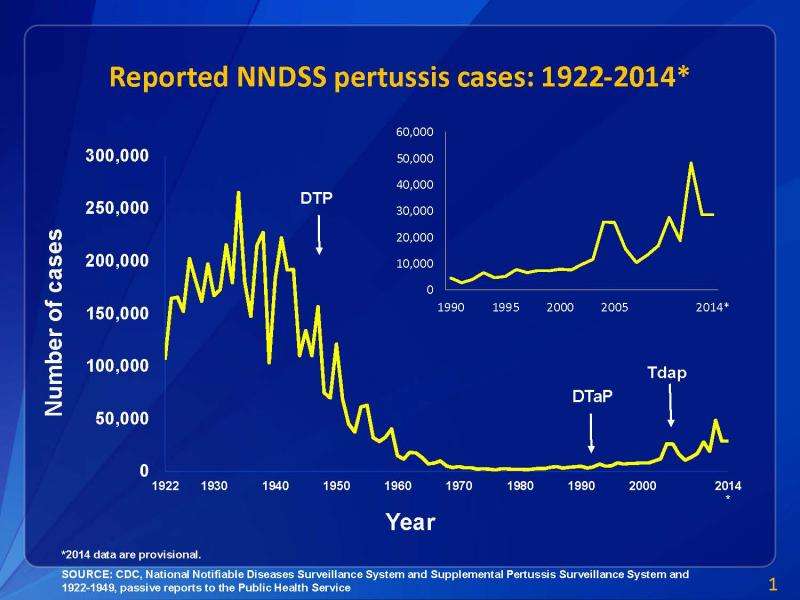Whooping cough: A small drop in vaccine protection can lead to a case upsurge

In 2012 the USA saw the highest number of pertussis (whooping cough) cases since 1955. New research finds that a likely explanation for this rise in disease is a drop in the degree of vaccine protection for each vaccinated individual.
A team led by Dr. Manoj Gambhir (Monash University, Melbourne, Australia), Dr. Thomas Clark (Centers for Disease Control and Prevention, Atlanta, USA), and Professor Neil Ferguson (Imperial College London, UK), worked with 60 years of pertussis disease data to determine what best explained the recent increase in the disease.
In the study published this week in PLOS Computational Biology, the authors investigate several hypotheses for the upsurge in pertussis cases using a mathematical modelling approach. The authors find that the level of protection of the currently-used 'acellular' vaccine is lower than that of the previously-used 'whole-cell' vaccine.
Other explanations of the upsurge in pertussis—most notably a steady increase in the reporting of cases over time, whether through better diagnostic techniques or an increasing awareness among medical practitioners of the disease—do not appear to be as fundamental as a change in protection between the current and former vaccines.
"We used a rigorous procedure for fitting several mathematical models to the data, and we found that a drop in protection was always necessary to reproduce the rising pattern of disease we've seen in the U.S.," says Dr. Gambhir. "Crucially, our model also matches the age pattern of disease."
These results demonstrate that the resurgence in pertussis in the U.S. can be explained by past changes in vaccination policy. However, the authors' findings also suggest that the efficacy of the currently-used acellular vaccine, while lower than that of the whole-cell vaccine, is not much lower (around 80% protection for the first three doses of acellular vaccine versus 90% for whole-cell), and booster doses may be sufficient to curtail epidemics while novel vaccine research continues.
"Pertussis has also been on the rise in several countries around the world, and we are eager to look at data from other countries to see whether the explanation for this is similar to what we found for the US." says Dr. Clark.
More information: Gambhir M, Clark TA, Cauchemez S, Tartof SY, Swerdlow DL, Ferguson NM (2015) A Change in Vaccine Efficacy and Duration of Protection Explains Recent Rises in Pertussis Incidence in the United States. PLoS Comput Biol 11(4): e1004138.DOI: 10.1371/journal.pcbi.1004138
















